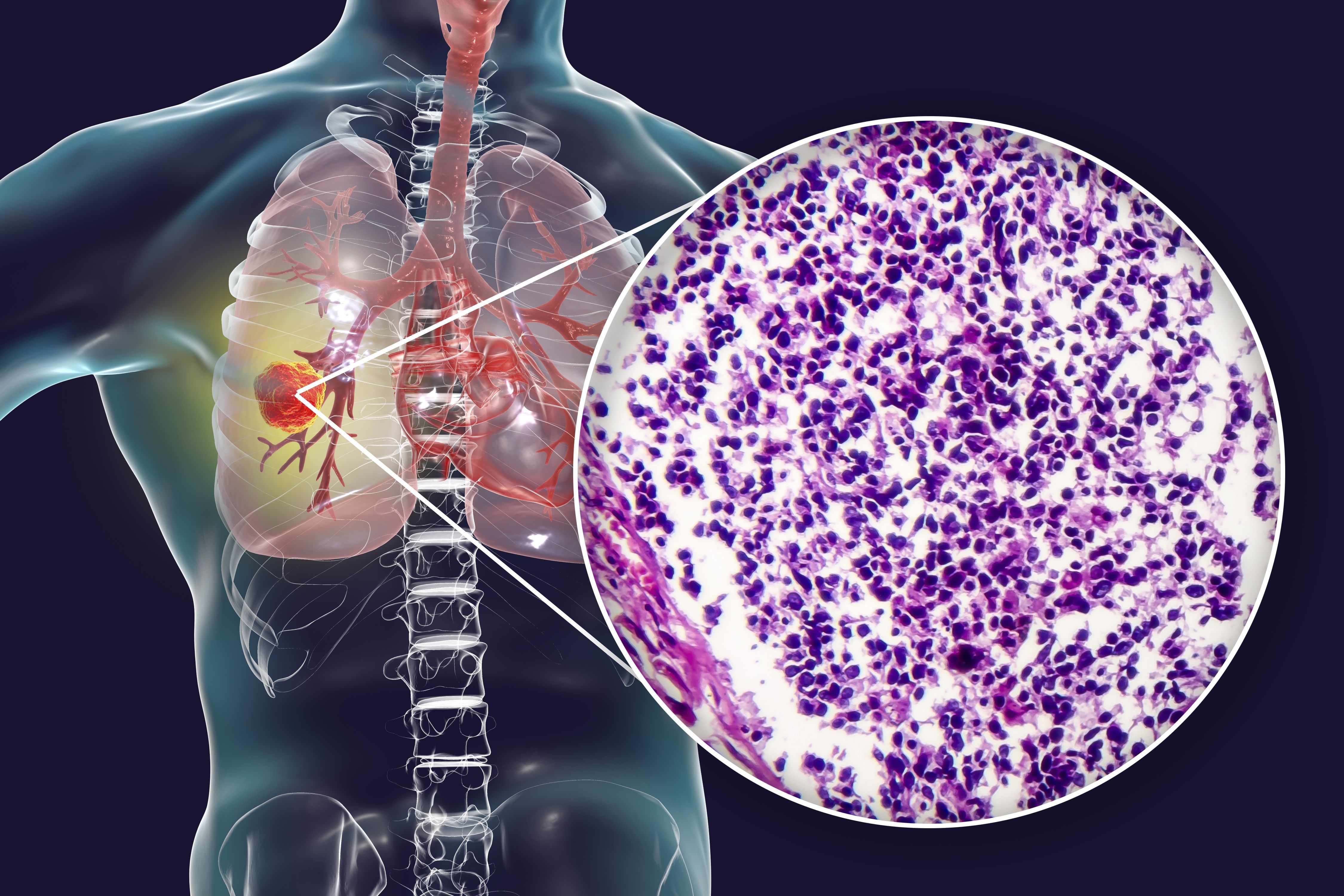Adjuvant Durvalumab Does Not Improve DFS Across NSCLC PD-L1 Subgroups
Patients with NSCLC across various subgroups did not see a disease-free survival benefit with adjuvant durvalumab compared with placebo.
“The outcomes of the BR.31 study suggest that the presence of primary disease and associated tumor antigens, as in the perioperative approach, may be required for optimal efficacy [in NSCLC],” according to Glenwood Goss, MB, BCh, FCPSA, FRCPC.

Disease-free survival (DFS) was not improved when adjuvant durvalumab (Imfinzi) was given after complete resection and optional chemotherapy vs placebo for patients with EGFR- or ALK-negative non–small cell lung cancer (NSCLC) across PD-L1 expression subgroups, according to results from the phase 3 BR.31 trial (NCT02273375) presented at the 2024 European Society of Medical Oncology (ESMO) Congress.
The median DFS in patients with PD-L1 expression of 25% or more in the durvalumab arm was 69.9 months (95% CI, 57.6-not reached [NR]) vs 60.2 months (95% CI, 47.7-NR) in the placebo arm (HR, 0.935; 95% CI, 0.706-1.247; P = .642). The 18-month DFS rate in the durvalumab arm was 75.1% (95% CI, 69.9%-79.6%) vs 70.5% (95% CI, 62.5%-77.1%) in the placebo arm. The 24-month rate was 71.2% (95% CI, 65.7%-75.9%) vs 68.5% (95% CI, 60.4%-75.3%), and the 36-month rate was 63.9% (95% CI, 58.2%-69.0%) vs 62.4% (95% CI, 54.1%-69.6%).
The median DFS in patients with PD-L1 expression of 1% or more was 59.9 months (95% CI, 48.4-77.9) in the durvalumab arm and 60.3 months (95% CI, 43.8-80.9) in the placebo arm (HR, 0.989; 95% CI, 0.788-1.248; P = .926). The 18-month DFS rates were 73.4% (95% CI, 69.0%-77.2%) vs 70.1% (95% CI, 63.6%-75.7%); 24-month rates were 68.6% (95% CI, 64.1%-72.7%) vs 67.0% (95% CI, 60.4%-72.7%); and 36-month rates were 60.2% (95% CI, 55.4%-64.5%) vs 60.1% (95% CI, 53.4%-66.3%), in the durvalumab and placebo arm, respectively.
For patients in the PD-L1 all-comer population, the median DFS was 60.0 months (95% CI, 49.6-74.9) in the durvalumab arm and 53.9 months (95% CI, 36.7-67.3) in the placebo arm (HR, 0.893; 95% CI, 0.752-1.065; P = .207). The DFS rates at 18 months were 72.1% (95% CI, 68.8%-74.9%) vs 66.0% (95% CI, 60.9%-70.6%); at 24-months, they were 67.4% (95% CI, 64.0%-70.6%) vs 63.3% (95% CI, 58.1%-68.0%); and at 36-months, they were 60.4% (95% CI, 56.8%-63.8%) vs 56.4% (95% CI, 51.1%-61.3%).
“The outcomes of the BR.31 study suggest that the presence of primary disease and associated tumor antigens, as in the perioperative approach, may be required for optimal efficacy [in NSCLC],” Glenwood Goss, MB, BCh, FCPSA, FRCPC, a professor of medicine in the University of Ottawa Division of Medical Oncology, a chair of the Thoracic Oncology Site Committee, and director of Clinical and Translational Research at Ottawa Hospital Cancer Centre, said in a presentation on these data.
Patients with stage IB to IIIA NSCLC who had complete resection, an ECOG performance status of 0 to 1, and EGFR-mutated/ALK-positive disease were eligible to enroll. Patients received a platinum doublet followed by surgery and randomization at 3 weeks or more. Patients were randomly assigned 2:1 to durvalumab at 20 mg/kg every 4 weeks for 12 months or matched placebo.
The primary end point was investigator-assessed DFS in patients with PD-L1 expression of 25% or more and EGFR- or ALK-negative disease. Secondary end points included DFS in patients who had PD-L1 expression of 1% or more and EGFR- or ALK-negative disease, all patients with PD-L1 expression of 25% or more, all randomly assigned patients, PD-L1 all comers with EGFR- or ALK-negative disease, and all patients with PD-L1 expression of 1% or more; overall survival; adverse effects (AEs); and quality of life.
Overall, 1827 patients registered, with randomization of 1415 taking place between February 2015 and March 2020. There was a total of 1219 patients with EGFR- or ALK-negative disease. Of the 1415 patients who were randomly assigned, 944 and 471 were assigned to the durvalumab arm and the placebo arm, respectively. At data cutoff, 67.7% of patients in the durvalumab arm and 67.5% in the placebo arm were still receiving study treatment.
In the PD-L1 expression of 25% or more group, the median age was 65 years old vs 63 years old in the durvalumab vs placebo arms, 61.1% vs 64.6% were male, 47.5% vs 41.0% were White, and 81.6% vs 79.5% were former smokers. Additionally, the most common histology type was adenocarcinoma in 63.0% vs 59.0%, 54.4% vs 50.9% had stage II disease, and 65.8% vs 64.6% had PD-L1 expression of 50% or more.
In the PD-L1 expression of 1% or more group, the median age was 65 years old vs 63 years old in the durvalumab and placebo arms, with 62.5% vs 64.6% being male, 46.1% vs 42.1% were White, and 78.3% vs 77.5% were former smokers. The most common histology type was adenocarcinoma in 60.8% vs 58.8%, and 44.3% vs 43.3% had PD-L1 expression of 50% or more.
In the PD-L1 all-comers group, the median age was 64 years vs 64 years in each arm, respectively; 64.8% vs 66.8% were male, 46.1% vs 46.5% were White, and 78.4% vs 76.5% were formers smokers. The most common histology type was adenocarcinoma in 66.3% vs 60.6%, and 42.5% vs 40.6% had PD-L1 expression of less than 1%.
The safety analysis included all patients who had received at least 1 dose of treatment. Any AEs occurred in 93.8% in the durvalumab arm and 92.3% in the placebo arm. Grade 3/4 AEs occurred in 23.5% vs 19.6%, and AEs leading to death occurred in 0.7% vs 0.2% between either arm. Serious AEs were observed in 18.8% vs 15.4%, and AEs leading to discontinuation occurred in 14.0% vs 5.1% in the durvalumab and placebo arms, respectively.
Reference
Goss G. CCTG BR.31: a double-blind placebo-controlled randomized phase 3 trial of adjuvant durvalumab in completely resected non-small cell lung cancer. Presented at the 2024 European Society of Medical Oncology (ESMO) Congress, Barcelona, Spain; September 13-17, 2024. LBA48.